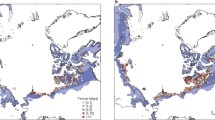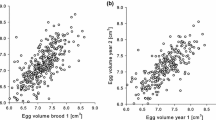Abstract
For passerine birds breeding in the Arctic, paternal effort in parental care is necessary for successful breeding. Behavioural strategies, such as mate guarding, to ensure paternity should therefore also be common in this environment. In order to investigate the relation between such behaviour and breeding success, when controlling for the effect of environmental factors, we recorded male mate-guarding behaviour, parental effort and breeding success amongst snow buntings, Plectrophenax nivalis, in the high Arctic environment of Spitsbergen, Svalbard. Mate-guarding intensity tended to positively affect male feeding frequency per nestling in one of the study years, negatively in 1 year and without effect in the 3rd year. The negative effect in 1999 was strong, but variation in estimates of the 2 other years was high and the effect of mate guarding may be negligible in these 2 years. We assume that this pattern might be related to yearly variation in the prevalence of extra-pair young. Male food provisioning was not positively related to breeding success, but late breeders had higher breeding success than early breeders. Thus, the effect of male mate guarding is highly variable and mainly affects food provisioning rates, but the benefit for total breeding success seems to be marginal, at best.



Similar content being viewed by others
References
Alatalo RV, Gustavsson L, Lundberg A (1986) Do females prefer older males in polygynous bird species? Am Nat 127:241–245
Alatalo RV, Glynn C, Lundberg A (1990) Singing rate and female attraction in the pied flycatcher: an experiment. Anim Behav 39:601–603
Avery MI, Krebs JR (1984) Temperature and foraging success of great tits Parus major hunting for spiders. Ibis 126:33–38
Bangjord G, Pedersen ÅØ, Djøseland O (1999) Hekkende snøspurv i fuglekasser på Svalbard. Vår Fuglefauna 22:109–111 [In Norwegian]
Beecher MD, Beecher IM (1979) Sociobiology of bank swallows: reproductive strategy of the male. Science 205:1282–1285
Bengtsson H, Ryden O (1983) Parental feeding rate in relation to begging behavior in asynchronously hatched broods of the great tit Parus major: an experimental study. Behav Ecol Sociobiol 12:243–251
Birkhead TR (1979) Mate guarding in the magpie Pica pica. Anim Behav 27:866–874
Birkhead TR, Møller AP (1992) Sperm competition in birds: evolutionary causes and consequences. Academic Press, London
Birkhead TR, Møller AP (1996) Monogamy and sperm competition in birds. In: Black JM (ed) Partnerships in birds: the study of monogamy. Oxford University Press, Oxford, pp 323–343
Brylawski AMZ, Whittingham LA (2004) An experimental study of mate guarding and paternity in house wrens. Anim Behav 68:1417–1424
Chuang-Dobbs HC, Webster MS, Holmes RT (2001) The effectiveness of mate guarding by male black-throated blue warblers. Behav Ecol 12:541–546
Cramp S, Perrins CM (1994) Buntings and new world warblers. Oxford University Press, Oxford
Gillott C (1995) Entomology, 2nd edn. Plenum, New York
Gottlander K (1987) Variation in the song rate of the male pied flycatcher Ficedula hypoleuca: causes and consequences. Anim Behav 35:1037–1043
Gowaty PA (1996) Battles of the sexes and origins of monogamy. In: Black JM (ed) Partnerships in birds. The study of monogamy. Oxford University Press, Oxford, pp 21–52
Gowaty PA, Bridges WC (1991) Nestbox availability affects extra-pair fertilizations and conspesific nest parasitism in eastern bluebirds, Sialia sialis. Anim Behav 41:661–675
Greig-Smith PW (1982) Seasonal patterns of song production by male stonechats. Saxicola torquata Orn Scand 13:225–231
Griffith SC, Owens IPF, Thuman KA (2002) Extra-pair paternity in birds: a review of interspecific variation and adaptive function. Mol Ecol 11:2195–2212
Grundel R (1987) Determinants of nestling feeding rates and parental investment in the mountain chickadee. Condor 89:319–328
Hoset KS, Espmark Y, Moksnes A, Haugan T, Ingebrigtsen M, Lier M (2004) Effect of ambient temperature on food provisioning and reproductive success in snow buntings Plectrophenax nivalis in the high Arctic. Ardea 92:239–246
Hussell DJT (1972) Factors affecting clutch size in Arctic passerines. Ecol Monogr 42:317–364
Hussell DJT (1985) On the adaptive basis for hatching asynchrony: brood reduction, nest failure and asynchronous hatching in snow buntings. Ornis Scand 16:205–212
Jennions MD, Petrie M (2000) Why do females mate multiply? A review of the genetic benefits. Biol Rev Cambridge Philosophic Soc 75:21–64
Johnsen A, Lifjeld JT (1995) Unattractive males guard their mates more closely: an experiment with bluethroats (Aves, Turdidae: Luscinia s. svecica). Ethology 101:200–212
Johnsen A, Lifjeld JT, Rohde PA (1997) Coloured leg bands affect male mate-guarding behaviour in the bluethroat. Anim Behav 54:121–130
Johnsen A, Lifjeld JT, Rohde PA, Primmer CR, Ellegren H (1998) Sexual conflict over fertilizations: female bluethroats escape male paternity guards. Behav Ecol Sociobiol 43:401–408
Kirkpatrick M (1985) Evolution of female choice and male parental investment in polygynous species: the demise of the “sexy son”. Am Nat 125:788–810
Kleven O, Lifjeld JT (2004) Extra-pair paternity and offspring immunocompetence in the reed bunting, Emberiza schoeniclus. Anim Behav 68:283–289
Kleven O, Lifjeld JT (2005) No evidence for increased offspring heterozygosity from extra-pair mating in the reed bunting (Emberiza schoeniclus). Behav Ecol 16:561–565
Kokko H, Morrell LJ (2005) Mate guarding, male attractiveness, and paternity under social monogamy. Behav Ecol 16:724–731
Lack D (1968) Ecological adaptations for breeding in birds. Chapman and Hall, London
Lyon BE, Montgomerie RD (1985) Incubation feeding in snow buntings: female manipulation or indirect male parental care. Behav Ecol Sociobiol 17:279–284
Lyon BE, Montgomerie RD (1987) Ecological correlates of incubation feeding: a comparative study of high arctic finches. Ecology 68:713–722
Lyon BE, Montgomerie RD, Hamilton LD (1987) Male parental care and monogamy in snow buntings. Behav Ecol Sociobiol 20:377–382
Marthinsen G, Kleven O, Brenna E, Lifjeld JT (2005) Part-time mate guarding affects paternity in male reed buntings (Emberiza schoeniclus). Ethology 111:397–409
Ottosson U, Backman J, Smith HG (1997) Begging affects parental effort in the pied flycatcher, Ficedula hypoleuca. Behav Ecol Sociobiol 41:381–384
Price T, Kirkpatrick M, Arnold SJ (1988) Directional selection and the evolution of breeding date in birds. Science 240:798–799
Reid JM, Monaghan P, Ruxton GD (2000) Resource allocation between reproductive phases: the importance of thermal conditions in determining the cost of incubation. Proc R Soc Lond B 267:37–41
Ringsby TH, Sæther BE, Tufto J, Jensen H, Solberg EJ (2002) Asynchronous spatiotemporal demography of a house sparrow metapopulation in a correlated environment. Ecology 83:561–569
Rodrigues M (1998) Mate guarding in the chiff chaff Phylloscopus collybita. Ethol Ecol Evol 10:55–66
Royama T (1966) Factors governing feeding rate food requirement and brood size of nestling Great Tits Parus major. Ibis 108:313–347
Siikamäki P (1996) Nestling growth and mortality of pied flycatchers Ficedula hypoleuca in relation to weather and breeding effort. Ibis 138:471–478
Skinner WR, Jefferies RL, Carleton TJ, Rockwell RF, Abraham KF (1998) Prediction of reproductive success and failure in lesser snow geese based on early season climatic variables. Glob Change Biol 4:3–16
Smith RD, Marquiss M (1994) Breeding season and nesting success of snow buntings in northeast Scotland. Scott Birds 17:223–234
R Development Core Team (2009) R: a language and environment for statistical computing. R Foundation for Statistical Computing, Vienna, Austria. ISBN 3-900051-07-0, URL http://www.R-project.org
Trivers R (1972) Parental investment and sexual selection. In: Campbell B (ed) Sexual selection and the descent of man. Aldine, Chicago, pp 136–179
Verboven N, Verhulst S (1996) Seasonal variation in the incidence of double broods: the date hypothesis fits better than the quality hypothesis. J Anim Ecol 65:264–273
Verboven N, Visser ME (1998) Seasonal variation in local recruitment of great tits: the importance of being early. Oikos 81:511–524
Verhulst S, van Balen JH, Tinbergen JM (1995) Seasonal decline in reproductive success of the great tit: variation in time or quality. Ecology 76:2392–2403
Winkler DW, Allen PE (1996) The seasonal decline in tree swallow clutch size: physiological constraint or strategic adjustment? Ecology 77:922–932
Acknowledgments
This study was undertaken as a part of a research project under The Royal Norwegian Society of Sciences and Letters’ Foundation (DKNVSS). It was funded by this Foundation (grant to YE) and the Norwegian Research Council (student grant to KSH, TH, MIW and ML). The University Centre on Svalbard (UNIS) provided some logistical support. Furthermore, we are indebted to Rolf Langvatn for logistical support during our stay in Longyearbyen. We also thank Eva Hofstad for assistance in the field and Bård G. Stokke for constructive comments on an earlier version of this paper.
Author information
Authors and Affiliations
Corresponding author
Rights and permissions
About this article
Cite this article
Hoset, K.S., Espmark, Y., Lier, M. et al. The effects of male mating behaviour and food provisioning on breeding success in snow buntings Plectrophenax nivalis in the high Arctic. Polar Biol 32, 1649–1656 (2009). https://doi.org/10.1007/s00300-009-0664-8
Received:
Revised:
Accepted:
Published:
Issue Date:
DOI: https://doi.org/10.1007/s00300-009-0664-8




